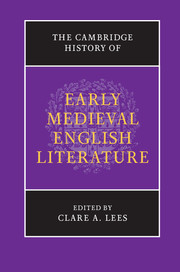Book contents
Introduction: literature in Britain and Ireland to 1150
Published online by Cambridge University Press: 05 February 2013
Summary
Taking to sea
The Parker Manuscript of the Anglo-Saxon Chronicle for 891 records that Dub Sláine, Mac Bethad and Máel Inmain crossed the Irish Sea in a rudderless boat, without sails and with little food. The three risk-takers did not care whether or not their food ran out or where their journey or pilgrimage ‘for Godes lufan’ took them, yet they landed in Cornwall and travelled on to the Anglo-Saxon court of King Alfred the Great. Immediately after this, the annal notes the death of the best teacher among the Scotti at that time, Suibhne (Swifneh in Old English). These celebrated stories of three men in a boat and of the excellence of Irish scholarship are not without precedent in the history of early medieval travel and cultural exchange. In the seventh century, the scholar-poet Aldhelm, bishop of Malmesbury, who may himself have benefited from Irish training, describes the English as travelling to Ireland like swarms of bees to learn from its scholars. The Chronicle entry for 891 opens, however, with an update on the activities of the Viking forces on the continent and the battle at Louvain (now in modern Belgium) between the Vikings, the East Franks, the Saxons and the Bavarians. The cultural world of the Anglo-Saxons, the earliest people to call themselves English, was informed as much by its interests and relations with the continental kingdoms as with its neighbours.
In the history of English literature the entry for 891 in the Parker Chronicle (manuscript A of the Anglo-Saxon Chronicle) is also noteworthy because it provides remarkable insight into how writing, as the technology of script and manuscript production, is a dimension of the broader conceptualization of history as written record in the early Middle Ages. Visible in the Chronicle entry is the moment when the second scribe of the manuscript takes over from the first and, with this transfer of hands, comes a new series of annals recording the final years of the reign of Alfred the Great. The evidence brings us close to the moment when the Chronicle was assembled in the late ninth or very early tenth century. The second scribe continues the reportage of events with an account of the sighting of a comet on or about the time of the liturgical season of Rogation, after Easter.
- Type
- Chapter
- Information
- Publisher: Cambridge University PressPrint publication year: 2012



